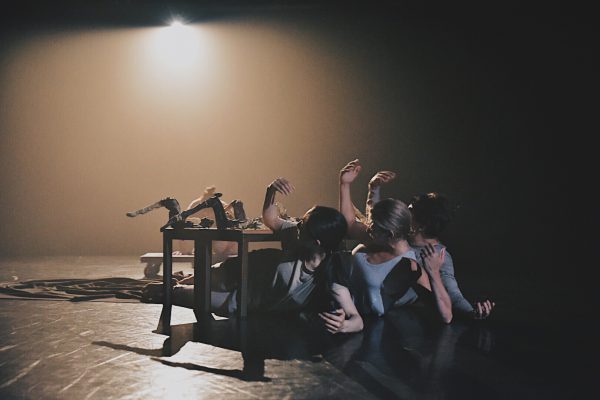The chairs of the theatre for Nova Bhattacharya’s Decoding Bharatanatyam bear notes for their guests. Each note is presented in the form of two heart-shaped papers, carefully pressed together, yet easily separable. Mine reads, “Bharatanatyam, your endings leave me wanting more.” The chair to my right declares, “Bharatanatyam is not story-telling, it’s story-being.” A few seats down, I notice Dr. Menaka Thakkar, Bhattacharya’s first guru and a Canadian dance icon. Interestingly, Bhattacharya was her first-ever student in Canada. As Thakkar speaks animatedly to those around her, I wonder what description of bharatanatyam she collected before sitting down.
The spirit of Decoding Bharatanatyam imitates the moments preceding the show — fluttering with discovery, while anchored in movement tradition. Partitioned into three pieces, the show is rendered into attempts to conceive a realm from the bones of what came before. The program is skillfully constructed to facilitate this process, beginning with José Navas’ striking fusion Calm Abiding, followed by Bhattacharya’s improvisational duet Broken Lines and transformative solo Alaap.
Before the initiation of the formal program, however, the audience is guided in the movement and intention of the namaskaram by Bhattacharya and fellow dancers. The namaskaram is the routine sequence performed at the start and end of a bharatanatyam session to express gratitude to God, the audience, our guru and Mother Earth — for letting us dance on her.
My hands meet my chest in synchronization with Bhattacharya, and we are united through movement and history. As the sequence unfolds, performers take turns narrating its symbolism, seamlessly transitioning between poses to evoke the cyclical nature of life and gratitude. The namaskaram concludes with Bhattacharya connecting the vast bodies of water that both surround and live within us; this serves as the undercurrent for the rest of the program.
The evening’s first piece, Calm Abiding, performed by Bhattacharya herself, is a fantastic clash between delicate movements and harsh sequences of nrita (pure dance). Montréal-based choreographer Navas brilliantly juxtaposes contemporary dance with bharatanatyam to create a structured frenzy. It begins with Bhattacharya centre stage in a dramatic spotlight, moving her arms and upper body with careful intention against a captivating silence. Suddenly, her eyes fling open and as if switched on, her movement gains momentum. She dances amongst two shadows now, one larger behind her, and another smaller, rippling from her feet.
The previous silence is then punctuated with overlapping voices, strategically arranged by composer Alexander McSween to form the sollukattu (vocal syllables) for Bhattacharya’s movement. The music possesses entrancing repetition, combining unidentifiable sounds with bouts of laughter. Unlike the gentle fluidity of the movement before, Bhattacharya performs intricate hand movements and footwork of traditional bharatanatyam adavus. Together, the movement and music have a hypnotic effect, daringly switching between hard and soft, kind and fierce, old and new.
The second piece, Broken Lines, is an improvisational duet, brimming with wit and playful energy. Practiced artists Neena Jayarajan and Atri Nundy riff off each other as they experiment with the possibility of creation through bharatanatyam. The stage is their practice space, and they expertly use abhinayam (facial expression) and hastas (hand gestures) to describe worlds that vanish as quickly as they appear. Jayarajan is dressed in yoga pants and a blue sweater, while Nundy wears the traditional dance sari. The dance sari is an unforgiving garment and serves as a running joke amongst the dancers. It becomes clear that Broken Lines is an ode to bharatanatyam dancers, and as one myself, I am delighted.
Jayarajan and Nundy move nimbly across the stage: running, skipping and jumping between scenes of their own imagination. Most notably, they re-enact epic Hindu battles, embodying Lord Shiva and Parvati one moment and Dushasana and Draupadi the next. They desperately try to one-up each other, spilling with ambition while sharing an affectionate sisterhood. During one scene, Nundy manifests a fruit, and Jayarajan desperately tries to take it from her. After an aggressive tug-of-war, Nundy produces another fruit with her left hand and says, “You know this is bharatanatyam, right? If you want another fruit, just create it.”
The final piece of the evening, Alaap, choreographed for Lucy Rupert by Bhattacharya, is a cosmic outpouring. Fluorescent purple light floods the stage, and as Rupert walks its perimeter with strong intent, her salangai (ankle bells) chime with each step. In Alaap, Rupert stumbles upon a universe and is desperately trying to communicate its details to us. Her movement is sharp and disjointed, beginning with a floor sequence illustrating inception and development. She lies on her side, stretching her legs in a swift circular motion, as though kicking through the fabric of the womb. Each kick is punctuated with a brief pause, breaking the movement into short segments.
At first glance, one may deem Alaap a contemporary number, but there are core bharatanatyam elements woven throughout. Particularly, the flexing and stomping of the feet and use of hastas for storytelling. The piece concludes with Rupert holding hamsasya, a hasta connecting the thumb and index finger, while other fingers remain extended in the air. Hamsasya has holy significance: its circular formation is said to radiate energy outward and back within. In Alaap, it redirects the energy of Rupert’s universe to the audience, and back again to Rupert.
In sum, Decoding Bharatanatyam is a triumphant exploration that has shifted across generations and geographic borders to manifest itself on a winter’s day in Toronto. Bhattacharya intuitively strings pieces together that imagine independent realms through the technique of bharatanatyam, while mixing contemporary and modern influences. Ultimately, she gives us insight into to the “Bengali girl from Scarborough” who became enamoured with this curious dance style many years ago — and we are left with a similar taste of that unending adoration.
~
A little goes a long way. Donate to The Dance Current today to support bold and inclusive coverage of dance in Canada.
Tagged: Bharatanatyam, Contemporary, Nova Bhattacharya, ON , Toronto






